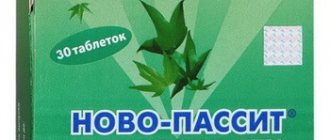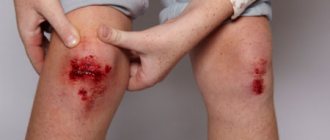In this article we will look at the treatment and prevention of tetanus.
It is an infectious disease, the main symptom of which is convulsive muscle contraction. The causative agent of the infection enters the body through the wound surface, for example, these can be cracks, burns, abrasions, wounds or punctures. Treatment can give good results, but only if diagnosed early; in some cases, death cannot be ruled out. This disease can also be prevented through a series of vaccinations.
Tetanus prevention is of interest to many people.
Dosages and methods of application
The tetanus toxoid vaccine is administered subcutaneously deep under the shoulder blade, 0.5 ml.
Active immunization:
- The course of vaccination with tetanus toxoid includes 2 vaccinations with a difference of 30-40 days and subsequent revaccination six months later. Further revaccinations are carried out every 10 years (this scheme is relevant for patients who have not previously been vaccinated against tetanus).
- In the case of an unorganized population, vaccination can be carried out according to a shortened course: a one-time administration of a double dose of toxoid, then revaccination after 6 months. (allowed up to 2 years) and further revaccinations every 10 years (one (0.5) dose).
- Children from 3 months of age are routinely vaccinated with DPT vaccine.
Emergency prophylaxis is indicated for:
- penetrating lesions of the gastrointestinal tract;
- injuries that are accompanied by a violation of the integrity of the mucous membranes and skin;
- animal bites;
- out-of-hospital abortions;
- long-term abscesses, gangrene, necrosis;
- childbirth outside a healthcare facility;
- burns (degree 2, 3, 4) and frostbite.
Such emergency prevention of tetanus involves mandatory wound treatment and early administration of a tetanus vaccine. What are the following drugs used for:
- Tetanus toxoid (instructions for use read: injected subcutaneously deep under the shoulder blade).
- Human tetanus immunoglobulin (250 units intramuscularly into the buttock).
- Horse anti-tetanus serum concentrated liquid purified (3000 units subcutaneously). Before using this drug, it is necessary to determine sensitivity - performing intradermal tests with serum, diluted 1:100.
Control questions
- 1. Etiology of tetanus.
- 2. Epidemiological features of tetanus.
- 3. Features of the pathogenesis of tetanus disease.
- 4. Classification of tetanus.
- 5. Clinic of tetanus: convulsive and neurovegetative syndromes.
- 6. Differential diagnosis of tetanus.
- 7. Complications of tetanus.
- 8. Treatment of tetanus as a resuscitation problem.
- 9. Basic therapeutic measures for tetanus.
10. Specific prevention of tetanus.
11. Nonspecific prevention of tetanus.
12. Emergency prevention of tetanus.
Side effects
Tetanus toxoid is a weakly reactogenic drug.
In rare cases, within two days after vaccination, rapid general (malaise, hyperthermia) and local (swelling, hyperemia) manifestations may occur. Allergic reactions in the form of urticaria, Quincke's edema and polymorphic rash occur extremely rarely, and in particularly sensitive patients to tetanus toxoid - an immediate reaction. In view of this, after vaccination, the patient is observed for half an hour, and all vaccination points are provided with anti-shock drugs.
Timing and algorithm for immunoprophylaxis against rabies after an animal bite
Rabies is an acute, highly contagious disease. It is caused by a virus that is localized in the central nervous system. It is transmitted mainly through the bites of infected animals and birds. Without prompt vaccination, the pathology ends in death.
Indications for emergency administration of rabies vaccination:
- receiving scratches and bites from an infected person (including damage through clothing);
- salivation of the skin or mucous membranes by rabid animals;
- injury by objects contaminated with the blood or saliva of rabid animals (cutting up a carcass, autopsy).
To prevent the development of infection, an anti-rabies vaccine is used.
Today, doctors most often administer the drug COCAB in combination with immunoglobulin (AIG). In total, at least 6 injections are given over three months. Emergency prevention of rabies with the COCAV vaccine is carried out within 14 days from the moment of possible infection.
Immunization at a later date is considered ineffective. AIH is best used within the first three days after expected contact with the virus.
Algorithm for preventing rabies after an animal bite:
- wash the infected area with a stream of boiled warm water and antibacterial soap;
- treat the edges of the damage with 70% alcohol. You can also use a 5% iodine solution as an antiseptic;
- apply a sterile bandage;
- visit the nearest medical center;
- Doctors will administer a rabies vaccine, as well as immunoglobulin. The person is under surveillance. COCAV is used in a standard single dose. The dosage of AIH is calculated depending on the body weight of the victim. Most of the drug is injected around the wound, and the rest is injected into the muscle.
Features of use
- It is forbidden to use the drug if the ampoule is damaged, missing labeling, improperly stored, if the period of use has expired or if the physical properties of the contents have changed (turbidity, sediment, color change).
- Opening of ampoules and vaccination are carried out in compliance with antiseptics and asepsis.
- The drug is not stored in an opened ampoule.
- Each vaccination is registered in special accounting forms, indicating the date of administration, manufacturer, batch and expiration date.
- Patients who have suffered acute pathologies are vaccinated no earlier than 30 days after recovery.
- In case of chronic pathologies, vaccination should be carried out a month after the onset of remission.
- Children with neurological diseases are vaccinated after the process has subsided.
- For patients with allergic diseases, immunization is carried out 2-4 weeks after the start of remission, while constant manifestations of pathology (hidden bronchospasm or localized skin manifestations) are not a contraindication for vaccination.
- In the presence of HIV and other immunodeficiencies, tetanus prevention is carried out as usual; when treating with corticosteroids and anticonvulsants, vaccination is carried out a year after the end of therapy.
- To determine possible contraindications, on the day of vaccination the doctor interviews the parents and examines the child, making sure to measure his temperature.
Scheme of routine and emergency vaccination against tetanus in adults and children
The tetanus vaccine is included in the list of mandatory ones. Vaccination according to the approved plan begins from infancy. Since the drug has a temporary effect, revaccinations are carried out at regular intervals throughout life.
Routine immunization of children against tetanus bacillus looks like this:
- The first vaccination is given at the age of three months;
- the second time the drug is injected after 45 days - at 4.5 months;
- the third injection is given when the baby reaches six months of age;
- revaccinated for the first time every 1.5 years;
- after 4.5-5.5 years the vaccination is repeated;
- Children are last immunized at age 14.
Children are vaccinated against tetanus with polyvalent drugs - DTP, ADS or ADS-M. Since the presence of antibodies in the body is limited, and people of all ages are susceptible to tetanus, adults continue to be vaccinated.
Previously immunized men and women begin to be vaccinated at 24-25 years of age. Injections are given every 10 years. To do this, use ADS or ADS-M. If an adult has not previously received a tetanus vaccine, then he is vaccinated twice with an interval of 35-40 days.
Then revaccinations are done every 10 years. In regions where the incidence of tetanus is increased, the interval between injections is halved.
Representatives of certain professions are immunized according to a simplified scheme:
- the first injection is given with a double dose of the drug;
- after 9-12 months they are revaccinated with a standard dosage;
- then vaccinations are repeated every 10 years.
Sometimes the schedule of routine vaccination against tetanus bacillus changes, for many reasons:
- refusal of parents or personal desire of an adult not to introduce antigenic material;
- poor health, prolonged illness (in this case, a medical exemption is given, the vaccination date is postponed until the period of full recovery);
- negative reaction to the first or second injection.
If the schedule is violated, the doctor develops an individual plan for further vaccination. Emergency prevention of tetanus involves the unscheduled urgent administration of a dose of toxoid. The vaccine is administered as soon as possible after possible infection. One dose is sufficient to prevent the development of infection.
Choice of drug for emergency prophylaxis of tetanus
If you have documents confirming vaccination:
- For children and adolescents who have previously completed the full age course of vaccination, tetanus toxoid preparations are not administered.
- For children or adolescents, when undergoing an immunization course, however, without the last age-specific vaccination, 1 dose (0.5) of tetanus toxoid is administered.
- For adults who have completed the full course of immunization (provided the last administration of toxoid was no more than 5 years ago), drugs for the prevention of tetanus are not used.
- If the adult’s vaccination course was complete, but the last vaccination was carried out more than 5 years ago, 0.5 (1 dose) of tetanus toxoid is administered for emergency prevention.
- If only one vaccination was carried out, but no more than 2 years ago, 1 dose of toxoid is indicated for any age group.
- Under the conditions described above, but the period of previous vaccine administration is more than 2 years, administration of 1 ml (2 doses) of toxoid, or 250 units. tetanus immunoglobulin, or 3000 units. antitetanus serum.
- If 2 vaccinations were given less than 5 years ago (for any age group), 1 dose of tetanus toxoid is recommended as emergency prophylaxis.
- In case of 2-time vaccination more than 5 years ago - 2 doses of tetanus toxoid/250 units. human tetanus immunoglobulin or 3000 units. antitetanus serum.
- If the patient is not vaccinated and his age is less than 5 months, administration of 250 units is recommended as emergency prophylaxis. human antitetanus immunoglobulin.
- In the absence of vaccinations against tetanus for patients of any age (except those described above), it is recommended to use 1 dose of tetanus toxoid, or 250 units, as an emergency immunization. human tetanus immunoglobulin, or 3000 units. antitetanus serum.
If there is no documentation of previous vaccinations:
- For emergency tetanus prophylaxis for children under 5 months of age, in the absence of contraindications to immunization, the drugs of choice are tetanus immunoglobulin (250 units) and antitetanus serum (3000 units).
- For children over 5 months and adolescents, in the absence of a history of contraindications to vaccination, it is recommended to administer 1 dose of tetanus toxoid.
- For military personnel (current and former), for the prevention of (emergency) tetanus, provided there is no history of contraindications for immunization, it is recommended to administer 0.5 (1 dose) of tetanus toxoid.
- For all other groups and age groups of patients, 3000 units are administered. serum, or 250 units. immunoglobulin, or 2 doses of tetanus toxoid.
Treatment of tetanus
Tetanus therapy is carried out in an intensive care unit, since a condition that threatens the patient’s life can occur at any time. Such a patient is not contagious to others, and, moreover, does not act as a source of spread of infection, and therefore those in contact with him are not at all exposed to any danger. Therefore, no disinfection is carried out. But such a patient needs to be on bed rest.
Any therapeutic measures must be carried out almost simultaneously in order to have time to neutralize the exotoxin along with its harmful effects on the body. The sooner treatment is started, including specific therapy using immunoglobulin or antitetanus serum, the more favorable the outcome and the greater the hope for complete healing.
We will tell you how to prevent tetanus later, but for now let’s talk in more detail about the treatment of the disease.
What vaccines are used for immunoprophylaxis?
Routine prophylaxis of tetanus is usually carried out with the domestic polyvalent drug DTP. But the list of vaccines against infection with this disease is wider.
To prevent the development of pathology, the following domestic products are used:
- AC. This is tetanus toxoid. One milliliter of the vaccine contains 20 units of active substance. The drug can be used during pregnancy;
- ADS-M. Protects against two infectious diseases - tetanus and diphtheria. A milliliter of the drug contains 10 units of each toxoid;
- PSS. It is an antitetanus purified horse serum. It already contains antibodies to the pathogen. Therefore, the drug acts faster than material that contains toxoids. PSS is used as an urgent prophylaxis for tetanus. The drug is well tolerated and rarely causes adverse reactions and complications;
- PSCH. This is human tetanus immunoglobulin. The concentration of the active substance is 250 IU. PSCHI is used for emergency immunoprophylaxis. Provides a protective level of toxoid in the patient’s blood for a month.
Imported analogues are also registered in Russia, these include the following drugs:
- D.T. VAK. This is a French vaccine against infection with diphtheria and tetanus bacilli. Suitable for those individuals who are prone to allergic reactions or have contraindications to immunization with the Russian ADS vaccine. Used for children from two months to 8 years of age;
- Imovax D.T. Adultery. This is a means of production in France. Suitable for protection against infection with diphtheria and tetanus bacilli from the age of 18.












